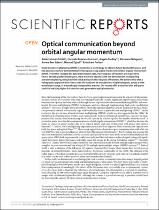JavaScript is disabled for your browser. Some features of this site may not work without it.
- ResearchSpace
- →
- Research Publications/Outputs
- →
- Journal Articles
- →
- View Item
| dc.contributor.author |
Trichili, A

|
|
| dc.contributor.author |
Rosales-Guzmán, C

|
|
| dc.contributor.author |
Dudley, Angela L

|
|
| dc.contributor.author |
Ndagano, B

|
|
| dc.contributor.author |
Salem, AB

|
|
| dc.contributor.author |
Zghal, M

|
|
| dc.contributor.author |
Forbes, A

|
|
| dc.date.accessioned | 2017-05-16T12:45:48Z | |
| dc.date.available | 2017-05-16T12:45:48Z | |
| dc.date.issued | 2016-06 | |
| dc.identifier.citation | Trichili, A., Rosales-Guzmán, C., Dudley, A.L. et al. 2016. Optical communication beyond orbital angular momentum. Scientific Reports, vol. 6: Article number: 27674. DOI: 10.1038/srep27674 | en_US |
| dc.identifier.issn | 2045-2322 | |
| dc.identifier.uri | DOI: 10.1038/srep27674 | |
| dc.identifier.uri | https://www.nature.com/articles/srep27674 | |
| dc.identifier.uri | http://hdl.handle.net/10204/9070 | |
| dc.description | © 2017 Macmillan Publishers Limited, part of Springer Nature. | en_US |
| dc.description.abstract | Mode division multiplexing (MDM) is mooted as a technology to address future bandwidth issues, and has been successfully demonstrated in free space using spatial modes with orbital angular momentum (OAM). To further increase the data transmission rate, more degrees of freedom are required to form a densely packed mode space. Here we move beyond OAM and demonstrate multiplexing and demultiplexing using both the radial and azimuthal degrees of freedom. We achieve this with a holographic approach that allows over 100 modes to be encoded on a single hologram, across a wide wavelength range, in a wavelength independent manner. Our results offer a new tool that will prove useful in realizing higher bit rates for next generation optical networks. | en_US |
| dc.language.iso | en | en_US |
| dc.publisher | Macmillan Publishers Limited, part of Springer Nature | en_US |
| dc.subject | Mode division multiplexing | en_US |
| dc.subject | MDM | en_US |
| dc.subject | Orbital angular momentum | en_US |
| dc.subject | OAM | en_US |
| dc.title | Optical communication beyond orbital angular momentum | en_US |
| dc.type | Article | en_US |
| dc.identifier.apacitation | Trichili, A., Rosales-Guzmán, C., Dudley, A. L., Ndagano, B., Salem, A., Zghal, M., & Forbes, A. (2016). Optical communication beyond orbital angular momentum. http://hdl.handle.net/10204/9070 | en_ZA |
| dc.identifier.chicagocitation | Trichili, A, C Rosales-Guzmán, Angela L Dudley, B Ndagano, AB Salem, M Zghal, and A Forbes "Optical communication beyond orbital angular momentum." (2016) http://hdl.handle.net/10204/9070 | en_ZA |
| dc.identifier.vancouvercitation | Trichili A, Rosales-Guzmán C, Dudley AL, Ndagano B, Salem A, Zghal M, et al. Optical communication beyond orbital angular momentum. 2016; http://hdl.handle.net/10204/9070. | en_ZA |
| dc.identifier.ris | TY - Article AU - Trichili, A AU - Rosales-Guzmán, C AU - Dudley, Angela L AU - Ndagano, B AU - Salem, AB AU - Zghal, M AU - Forbes, A AB - Mode division multiplexing (MDM) is mooted as a technology to address future bandwidth issues, and has been successfully demonstrated in free space using spatial modes with orbital angular momentum (OAM). To further increase the data transmission rate, more degrees of freedom are required to form a densely packed mode space. Here we move beyond OAM and demonstrate multiplexing and demultiplexing using both the radial and azimuthal degrees of freedom. We achieve this with a holographic approach that allows over 100 modes to be encoded on a single hologram, across a wide wavelength range, in a wavelength independent manner. Our results offer a new tool that will prove useful in realizing higher bit rates for next generation optical networks. DA - 2016-06 DB - ResearchSpace DP - CSIR KW - Mode division multiplexing KW - MDM KW - Orbital angular momentum KW - OAM LK - https://researchspace.csir.co.za PY - 2016 SM - 2045-2322 T1 - Optical communication beyond orbital angular momentum TI - Optical communication beyond orbital angular momentum UR - http://hdl.handle.net/10204/9070 ER - | en_ZA |






